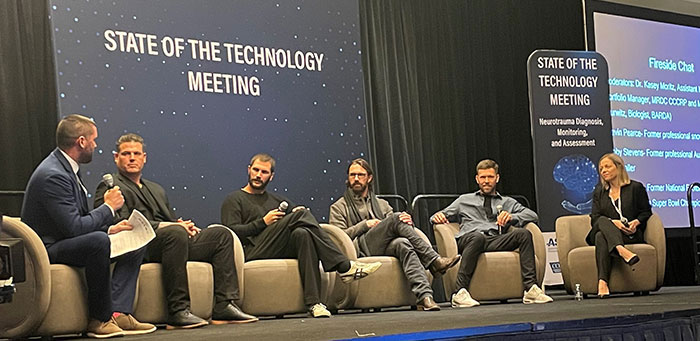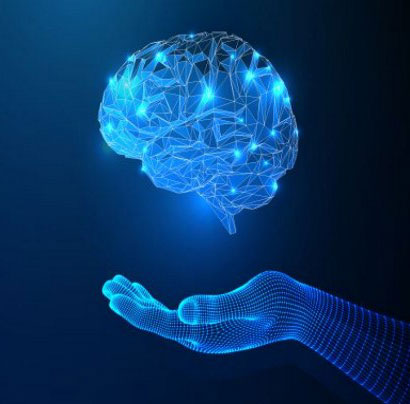Brain Injury Awareness and CCCRP's State of Technology Meeting

(Photo credit: Hayley Rogers, CCCRP).
In honor of the recent Brain Injury Awareness Month in March, the U.S. Army Medical Research and Development Command's Combat Casualty Care Research Program is highlighting a significant achievement within its Neurotrauma Portfolio.
Principally striving to "close military-relevant gaps in combat-related traumatic brain injury from the battlefield through acute hospitalization," the Neurotrauma Portfolio is determined to meaningfully advance the TBI space with both knowledge and materiel solutions. Supplementary efforts include the refinement of clinical practice guidelines, the establishment of individualized approaches to casualty management and the oversight of active clinical trials testing several therapeutics for the acute treatment of TBIs, as well as studies developing technologies to noninvasively diagnose, assess and monitor TBI casualties in the far-forward environment.
The Neurotrauma Portfolio is managed by Drs. J.B. Phillips and Kasey Moritz, under the support of CCCRP's leadership team, which includes Capt. Travis M. Polk as Director, Maj. Elaine Por as Military Deputy Director and Dr. Therese West as Civilian Deputy Director.
The Neurotrauma Portfolio collaborates with federal, academic and industry partners to improve the understanding of TBI mechanisms and move diagnostic and treatment capabilities from the discovery phase through early-stage clinical testing.
Traumatic Brain Injuries and Military Members
The Military Health System recognizes five types of TBIs: concussion, extra-axial hematoma, contusion, traumatic subarachnoid hemorrhage and diffuse axonal injury. No matter the diagnosed severity of a TBI, all injuries to the brain are critical.
Therefore, TBIs are a foundational concern for the U.S. military. Amidst combat and explosions, military personnel are especially vulnerable to this type of injury. With 492,167 Service Members diagnosed with TBIs worldwide between 2000 and 2023, CCCRP understands that improved diagnosis and treatment are crucial for treating this invisible wound of war.
State of Technology Meeting

(Photo credit: Hayley Rogers, CCCRP).
Befitting Brain Injury Awareness Month, the Neurotrauma Portfolio teamed up with the Biomedical Advanced Research and Development Authority to co-host the first ever TBI Diagnosis, Assessment and Monitoring State of Technology Meeting March 12 and 13.
The State of Technology Meeting, conceived by Dr. Moritz, aimed to assemble the TBI community and its collective knowledge regarding focused and noninvasive neuro-assessment tools in order to better diagnose and manage TBIs at all levels of the continuum of care, understand how to monitor patients already diagnosed with TBIs and identify new potential products that could be further developed into prototypes for the diagnosis, assessment and monitoring of TBIs.
Held at the Walter E. Washington Convention Center, the event hosted more than 300 registered participants from around the world and kicked off with addresses by CCCRP's Dr. Phillips and BARDA's Dr. Narayan Iyer.
After giving a brief introduction to CCCRP's neurotrauma mission and scope, Dr. Phillips shared expectations for the meeting—emphasizing the importance of active participation to enable the greatest constructive outcome. Expressing heartbreak for the lives that have been lost or considerably altered due to a lack of diagnosis and subsequent treatment, Dr. Phillips ended his address by explaining that, with improved TBI knowledge and technology, things could be different.
Dr. Iyer followed the speech by affirming the focus on the lives directly affected by the supply of TBI resources. He then moved on to share some of the current gaps in TBI detection and management, listing technology shortfalls; standardization; and the slow, deliberative process of translating products from research to clinical practice.
Continuing the meeting's focus on lived-experience, Kevin Pearce, former professional snowboarder and co-founder of the Love Your Brain Foundation was next to take the stage.
Sharing clips from his 2013 documentary, The Crash Reel, Pearce chronicled his unexpected change from being one of the world's best snowboarders, to one of the world's best-known TBI survivors. After sustaining a TBI from a severe crash during his training for the Vancouver Winter Olympics, Pearce spent one week in a coma, one month in intensive care, three months in rehabilitation (relearning motor skills such as walking, talking and swallowing) and years regaining the physical and cognitive abilities he once effortlessly possessed. Though Pearce's original goal was to win gold, his new goal became recovery.
Joining Pearce in attendance were former professional Australian rules footballer; Koby Stevens, three-time Super Bowl champion; Lonie Paxton and former Navy SEAL; Lt. Pete Scobell. Following the keynote speech, the four guests were interviewed by CCCRP's Dr. Moritz and BARDA's Janelle Hurwitz in a fireside chat about their experience with TBIs and how to change the athletic and military "team/family" mentality of staying in the game or fight with a brain injury.
The interviewees' experiences served as actualized examples of TBI ramifications and can be seen in their upcoming documentary Thrive. To learn more about Thrive, visit here.
During an opening session titled "End User Vignettes: Constraints and Considerations," a panel of expert – including Master Sgt. Hunter Black, Senior Enlisted Advisor for the U.S. Army Medical Materiel Development Activity; Lt. Col. Brad Dengler, Director for the Military Traumatic Brain Injury Initiative; Dr. Frank Guyette, Professor of Emergency Medicine at the University of Pittsburgh; Dr. Jeff Bazarian, Professor of Emergency Medicine at the University of Rochester Medical Center; Dr. David Okonkwo, Professor of Neurosurgery at the University of Pittsburgh; Dr. Andrea Schneider, Assistant Professor of Neurology at the University of Pennsylvania; and Dr. Susan Rowell, Professor of Surgery at the University of Chicago – spoke with honesty and passion about the need for change regarding TBI care.
The group discussed currently available and developing products such as biomarker devices, which use measurements to capture what is happening within the body to serve as an early warning system to health care providers. Though they were excited about the possibilities of biomarker devices, they also unanimously agreed that more research is necessary to determine whether biomarker information could be useful in reducing risks such as secondary injury. The ability to objectively and accurately detect a TBI would largely benefit health care providers in appropriately treating patients while explicitly striving to avoid additional secondary injury.
Eager to improve care for TBI patients, the group spoke about the current gaps in military and civilian health care and encouraged the audience to focus on collecting more TBI data, as well as creating technology with multiple uses to compensate for the limited number of supplies Warfighters and EMTs are able to carry.
The State of Technology Meeting moved on to include discussions on classification updates, transitions from research to action, artificial intelligence, international perspective from TBI collaborations with the UK and regulatory considerations.
The event concluded with a final breakout group, which shared overarching outcomes and suggestions. Based on the meeting's discussions and activities, the group offered three main observations:
- Some technology areas, such as noninvasive monitoring and intracranial pressure, will be more adoptable by the clinical community than by others.
- An increase in blood-based biomarker specificity could be beneficial in indicating structure damage. Furthermore, the blood-based biomarker data needs to be more "patient level" focused, while also enabling devices and modalities for risk stratification.
- End-user involvement throughout the construction process of apps and in-home technology is ideal. Recognition that there may be barriers when attempting to combine separate company technologies is advised.
CCCRP extends a special thanks to the Medical Technology Enterprise Consortium for running the State of Technology Meeting, as well as to BARDA for its continued collaboration and co-sponsorship of the event.















